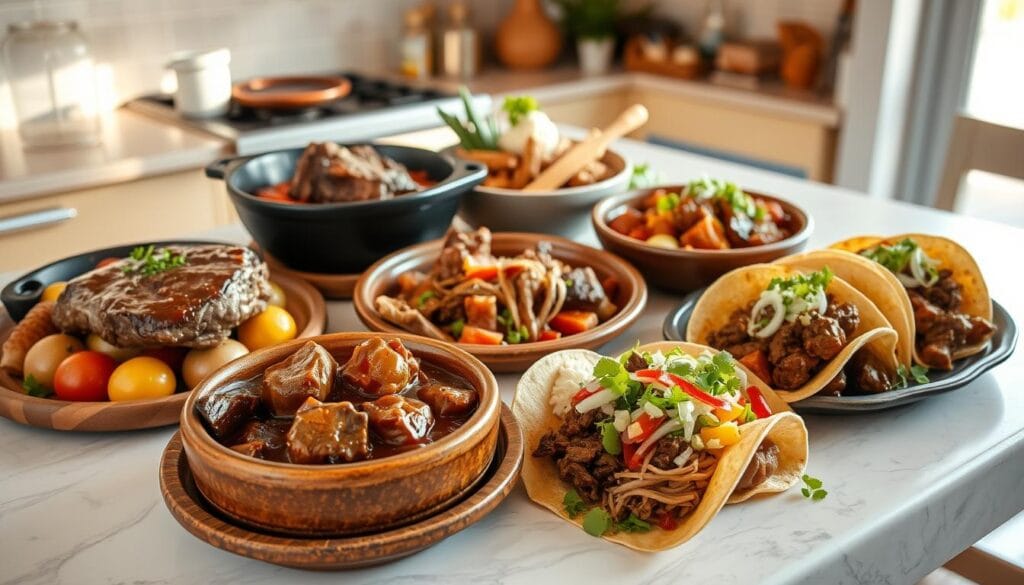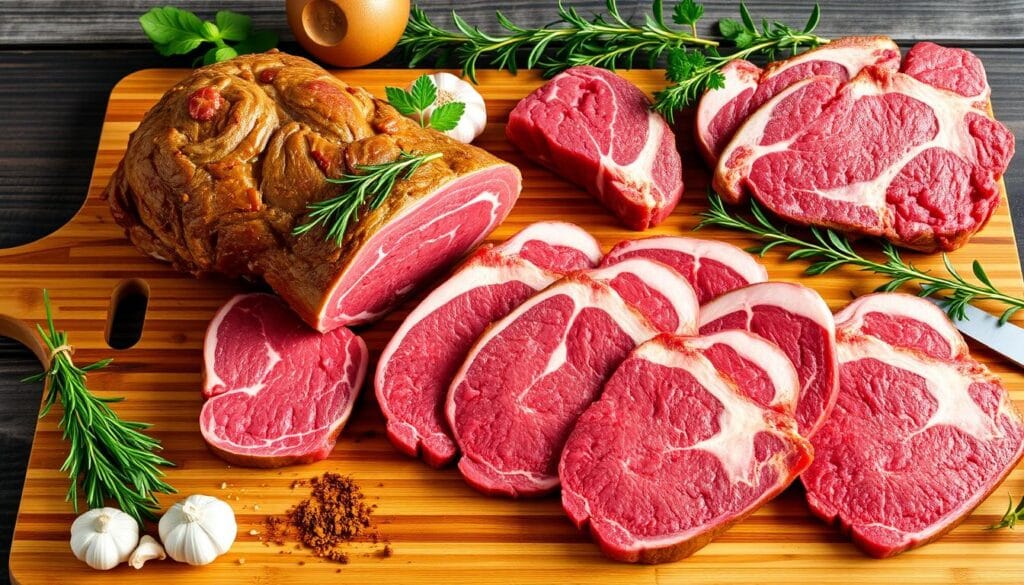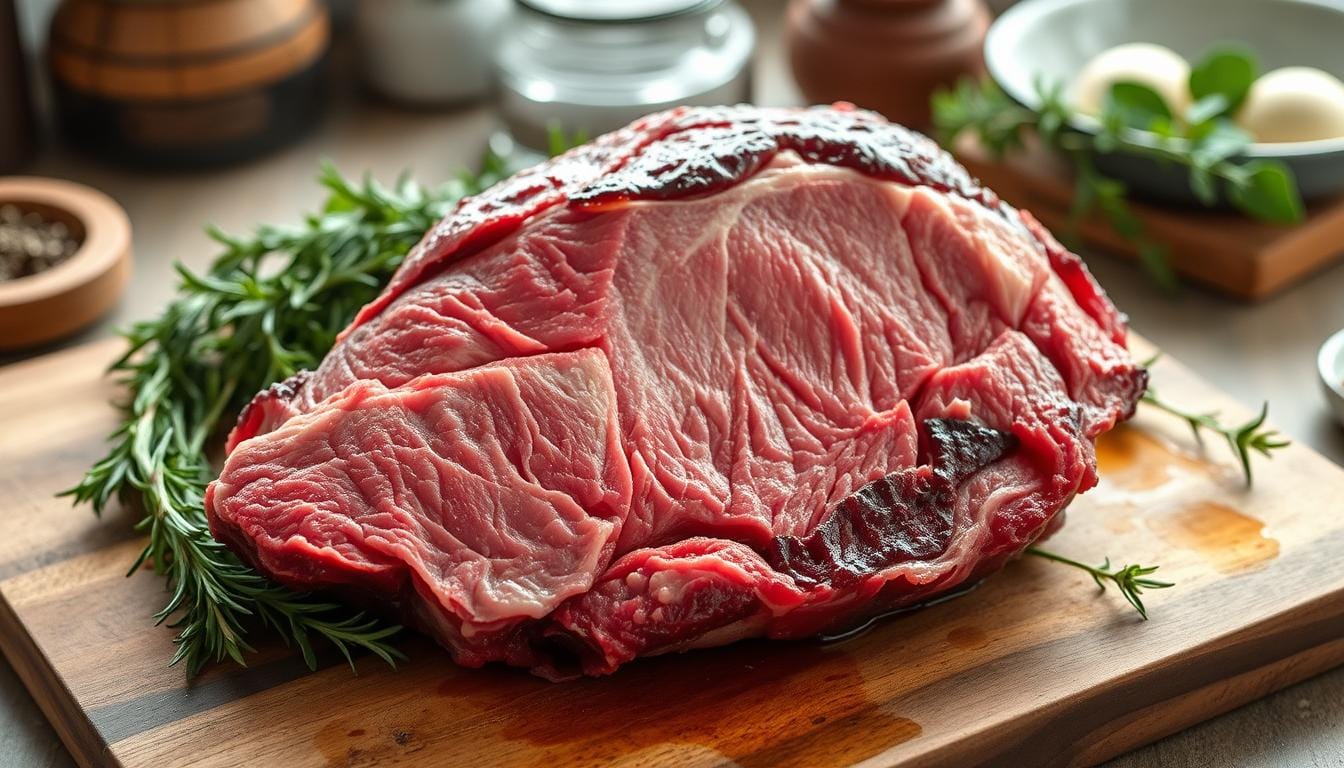I love cooking at home and enjoying a good steak. Beef chuck is a cut that’s often ignored, but it’s full of flavour. It’s not as popular as ribeye or tenderloin, but it’s a treasure for those who love a good chuck steak.
In this guide, we’ll explore beef chuck in depth. We’ll look at where it comes from, its role in the Australian beef industry, and how to use it in your cooking. Whether you’re experienced or new to cooking with beef, you’ll learn something new and useful.
Table of Contents
Key Takeaways
- Beef chuck is a budget-friendly and flavourful cut from the shoulder area of the cattle.
- It’s known for its rich marbling and versatility, making it suitable for a variety of cooking methods.
- Beef chuck is an integral part of the Australian beef industry, providing a cost-effective option for consumers.
- Proper selection, preparation, and cooking techniques can unlock the full potential of this underappreciated cut.
- Exploring the diverse world of beef chuck can expand your culinary horizons and broaden your appreciation for the Australian beef industry.
Understanding Beef Chuck: From Paddock to Plate
Beef chuck is a top cut in Australia, coming from the cow’s shoulder and neck. It’s a key part of the country’s cattle farming and beef making. This cut is both versatile and full of flavour.
Location on the Cattle
The beef chuck comes from the cow’s shoulder and neck. This area is well-exercised, making the meat tender and full of flavour. It’s a favourite among Australians and chefs for its unique taste.
Characteristics of Chuck Meat
Beef chuck has a great mix of lean meat and fat. This mix keeps the meat tender and adds flavour, important for beef nutrition. It’s perfect for many cooking styles, from slow-cooking to grilling, pleasing many tastes.
Role in Australian Beef Industry
In the meat industry, beef chuck is crucial. It’s a big part of ground beef, a common food in Australian homes. It’s also great for making different dishes, like stews and roasts. This makes it a key player in cattle farming and Australian cooking.
The Rich History of Chuck in Australian Cuisine
Australian beef is known for its quality and tradition. The beef chuck is a key part of this heritage. It’s a staple in Australian homes, featured in classic dishes that highlight the country’s meat-centric cuisine.
The beef chuck’s popularity in Australia comes from its affordability and rich flavor. It’s a favorite for both home cooks and chefs, making it a budget-friendly choice. It’s great for slow-cooked roasts and stews, adding depth and flavor to meals.
The beef chuck also shows Australia’s strong connection to its agricultural past. As a major beef producer, Australia values its cattle. The chuck is a symbol of the country’s love for meat and its beef industry.
Today, the beef chuck remains a favorite in Australian kitchens. Home cooks and chefs are always finding new ways to use it. Its lasting appeal in Australian cuisine celebrates the nation’s love for beef and its culinary traditions.
Nutritional Profile and Health Benefits
Beef chuck is packed with nutrients like high-quality protein, minerals, and vitamins. A 100g serving of lean, cooked beef chuck has about 22-26g of protein. This supports muscle growth and maintenance. It’s also rich in iron, zinc, and selenium, meeting your body’s nutritional needs.
Beef chuck has around 197 kilocalories per 100g, offering a good balance of macronutrients. It has 12g of fat per 100g, mostly unsaturated fats. It also contains beneficial compounds like creatine, taurine, and CLA, which can improve exercise performance and health.
Protein and Mineral Content
Beef chuck is a great source of high-quality protein, with 22g per 100g serving. This protein is vital for building and repairing tissues, supporting muscle growth, and maintaining bodily functions. It’s also rich in minerals like iron, zinc, and selenium, crucial for red blood cell formation, immune function, and antioxidant protection.
Calories and Fat Composition
Beef chuck has a moderate amount of fat, but most of it is unsaturated fats. A 100g serving has 12g of total fat, with only 4.5g being saturated fat. This balanced fat profile makes it a nutritious addition to a balanced diet when eaten in moderation.
Dietary Considerations
It’s important to consider your dietary needs and preferences when eating beef chuck. If you’re watching your sodium intake, be careful of processed beef products like sausages. They can be high in sodium. If you have heart disease or are at risk, talk to a healthcare professional about how much beef to eat as part of a balanced diet.
Different Types of Beef Chuck Cuts
The beef chuck is a versatile and flavorful section of the cattle. It offers a wide range of cuts for various cooking methods. Whether it’s slow-braised dishes or grilled steaks, the chuck has something for everyone.
The chuck roast is a popular cut from the chuck. It’s also known as blade roast, 7-bone roast, or arm roast. This cut is perfect for slow cooking, like braising. The tough meat becomes tender and flavorful when cooked low and slow.
- Short ribs, another versatile cut from the chuck, can be substituted with beef ribs, beef shank, or oxtail for similar cooking applications.
- The flat iron steak, a relatively new cut, is a tender and flavorful option. It can be used in place of flank steak or skirt steak.
Other cuts from the chuck include the chuck eye steak and the shoulder steak. The chuck eye steak can be grilled like a ribeye. The shoulder steak is great for braising and slow cooking.
Choosing any cut from the beef chuck is a reliable and cost-effective option. It can be transformed into a wide range of delicious dishes. By understanding the unique characteristics and best cooking methods for each cut, you can unlock the full potential of this flavorful section of the cow.
Selecting Quality Chuck at the Butcher
Choosing quality beef chuck means looking closely at how it looks. It should be a bright, vibrant red, showing it’s fresh. Even marbling, or fat, makes the meat tender and flavorful.
Visual Indicators of Quality
First, check the chuck’s color. It should be a bright, cherry-red without any discoloration. The texture should be firm but soft, not dry or too wet. Stay away from dull, gray, or slimy cuts.
Marbling Assessment
Marbling, or the fat inside the meat, is key. Look for fine, white streaks all over. Even marbling means the meat will be tender and tasty. Avoid cuts with big fat pockets for a better taste.
Storage Tips
- Keep beef chuck in the fridge at 4°C (40°F) or lower.
- Use it within 3-5 days for the best taste and safety.
- Freeze it at -18°C (0°F) or lower for up to 12 months.
- Thaw frozen chuck in the fridge overnight for safe defrosting.
By focusing on looks, marbling, and storage, you’ll pick the best beef chuck. This ensures a tasty and enjoyable meal.
Popular Cooking Methods for Chuck
Beef chuck is a versatile and flavorful cut that works well with many cooking techniques. It’s perfect for making hearty beef recipes or trying out new cooking techniques. Chuck can be the main attraction in your dishes.
Slow cooking is a favorite way to prepare chuck. A chuck roast takes 30 to 35 minutes per pound to slow roast in the oven. This breaks down the tough tissues and blends the flavors. For a tender, shreddable texture, cook it until it reaches 195°F to 205°F.
Braising is another great method for chuck. It involves searing the meat and then simmering it in a flavorful liquid, like beef broth. This makes a rich, tender dish that’s great for stews or pot roasts.
- A classic chuck tender roast recipe calls for ingredients like garlic, herbs, olive oil, and beef broth.
- Calorie counts in chuck recipes can range from 267 to 626 per serving, with fat content varying from 14g to 34g.
- Cooking times for chuck dishes can range from 165 minutes to over 8 hours, depending on the method and recipe.
For a quicker option, grilling or pan-searing chuck steaks is tasty. The natural marbling in chuck keeps the meat moist and flavorful, even with high-heat cooking.
Beef chuck is a fantastic ingredient that can make your meals hearty and satisfying. Try different techniques and flavors to find your favorite beef recipe.

Slow Cooking and Braising Techniques
Beef chuck is best cooked slowly to bring out its rich flavor. Whether you’re making a stew or a roast, slow cooking is essential. It makes the meat tender and juicy.
Temperature Control
For slow cooking, keep the heat low, between 150-170°C. This gentle heat breaks down the meat’s tough parts. It turns the beef into a tender, delicious treat.
Be patient. Cooking a 1kg beef chuck roast takes 3-4 hours. Adjust the time for bigger cuts.
Liquid Ratios
When braising, use enough liquid to cover about one-third of the meat. You can use broth, wine, or a mix of both. The liquid tenderizes the beef and makes a tasty sauce.
This sauce is great over mashed potatoes, polenta, or bread.
Timing Guidelines
Braising takes 2-3 hours to make tough chuck tender. First, brown the meat to get a tasty crust. Then, simmer it in liquid until it’s very tender.
“The key to unlocking the full flavor and tenderness of beef chuck is to embrace the beauty of slow cooking and braising. With a little patience and the right techniques, this humble cut can become the star of your next hearty, comforting meal.”
Flavour Profiles and Seasoning
Beef chuck is known for its rich, beefy taste. It goes well with many seasonings and marinades. Finding the right flavours can make this cut even more delicious.
A smoky and sweet spice mix is a favourite. It includes smoked paprika, brown sugar, garlic powder, and a bit of cayenne pepper. This mix brings out the beef’s flavour and adds depth.
For a fresh taste, try a mix of rosemary, thyme, garlic, and lemon zest. These herbs and citrus notes balance the beef’s flavour.
Want something spicier? Mix chilli powder, cumin, coriander, and lime juice. This marinade tenderises the chuck and adds bold flavours.
For a richer taste, use soy sauce, Worcestershire sauce, garlic, and black pepper. This mix enhances the beef’s natural flavour, creating a deep taste experience.
For the perfect roast beef, a simple spice rub is key. Use smoked paprika, coarse salt, black pepper, garlic powder, onion powder, thyme, rosemary, mustard powder, cayenne pepper, and coriander.
Choose your flavour and marinate the chuck for at least 2 hours, or overnight. Piercing the beef helps the flavours penetrate deeper. Save some marinade for basting to keep the meat moist and flavourful.
Chuck Roast vs Chuck Steak: Understanding the Difference
The chuck section of beef offers many options, each with its own special qualities. Two popular choices are the chuck roast and the chuck steak. Both have strong beef flavors but differ in texture.
Texture Variations
A chuck roast is a bigger, tougher cut. It’s best cooked slowly, like braising or stewing. This cut comes from the muscle between the neck and shoulder blade. It has a varied texture because of the different muscle groups.
On the other hand, a chuck steak is thinner and more uniform. It’s great for quick cooking methods like grilling or pan-searing.
Best Uses for Each Cut
- Chuck Roast: Perfect for pot roasts, stews, and slow-cooked dishes. It’s great because the tough connective tissues break down and the flavors blend well.
- Chuck Steak: Ideal for quick-cooking methods like grilling, pan-searing, or stir-frying. This way, the meat can be cooked to your liking.
Beef chuck is both affordable and versatile. It can be turned into many tasty dishes with the right cooking methods. Knowing the difference between a chuck roast and a chuck steak helps you use this flavorful and budget-friendly beef cut to its fullest potential.

Economic Benefits of Choosing Chuck
Chuck is a hidden gem for affordable beef. It’s a great value, perfect for Australian families on a budget. You get tasty and nutritious meals without spending too much.
Chuck is much cheaper than cuts like ribeye or tenderloin. A chuck roast costs about $6 to $8 per pound. Ground beef is around $6.73 per pound. But ribeye steaks can be $12 to $15 per pound. Choosing chuck means you get great taste and tenderness at a lower price.
| Beef Cut | Average Price per Pound |
|---|---|
| Ground Beef | $6.73 |
| Ribeye Steak | $12 – $15 |
| Chuck Roast | $6 – $8 |
Chuck is also very versatile. You can make stews, braises, burgers, and meatballs with it. This means you can make lots of tasty, budget-friendly meals for your family.
Buying a whole or half cow can save you a lot of money. Getting it from local farms or through a CSA program can make beef even cheaper. This makes it easier for Australian families to enjoy affordable beef and budget-friendly meals.
“Choosing chuck over premium cuts is a smart way to enjoy the flavour and nutrition of beef without the high price tag. It’s a true game-changer for budget-conscious Australian families.”
Sustainable and Ethical Chuck Production
Australian consumers are now more aware of their food’s impact. This has led to a focus on sustainable and ethical beef production. Beef chuck, a tasty and versatile cut, is being produced with care for the environment and animal welfare.
Grass-fed cattle are a key part of sustainable chuck production. Grass-fed beef has more omega-3 fatty acids than regular beef. It also has more conjugated linoleic acid (CLA), which helps with weight loss and diabetes prevention.
Responsible land use is another important aspect of sustainable beef. Grass-fed cattle don’t need synthetic fertilizers. This makes grass-fed beef better for the environment. Plus, it’s free from antibiotics and hormones, unlike some conventional beef.
| Sustainable Beef Attribute | Benefit |
|---|---|
| Grass-fed Beef |
|
| Responsible Land Management |
|
While sustainable chuck might cost a bit more, it’s worth it for our health and the planet. As the Australian beef industry grows, choosing sustainable sustainable beef and ethical farming becomes easier.
“Sustainable beef production is not just a trend, it’s a necessity for the future of our planet and the well-being of our communities.”
Conclusion
Beef chuck is a versatile, flavorful, and affordable cut in Australian cuisine. It’s loved for its rich taste, health benefits, and many cooking techniques it suits. Learning how to pick, prepare, and cook beef chuck can make your meals better and save money.
The Australian beef industry values the chuck highly. This guide has covered its location, unique traits, and history in Australian cooking. It’s shown the nutritional value, different cuts, and cooking methods, offering great tips for using this ingredient.
Whether you’re grilling, braising, or adding it to stews or casseroles, knowing the cut’s characteristics is key. By mastering beef chuck, you’ll create delicious meals that will wow your loved ones.
FAQ
What is beef chuck?
Where does beef chuck come from on the cow?
What role does beef chuck play in the Australian beef industry?
What are the nutritional benefits of beef chuck?
What are the different types of beef chuck cuts?
How should you select and store beef chuck?
What are the popular cooking methods for beef chuck?
How do you slow cook and braise beef chuck?
How does the flavour of beef chuck compare to premium cuts?
How is beef chuck production impacted by sustainable and ethical practices?
Did You Try Our Recipe?
There are no reviews yet. Be the first one to write one.

